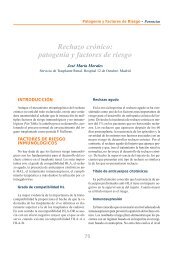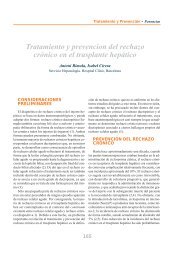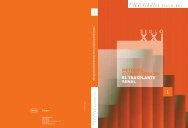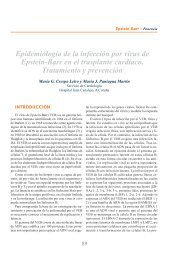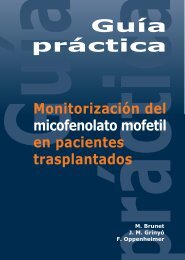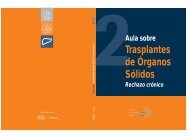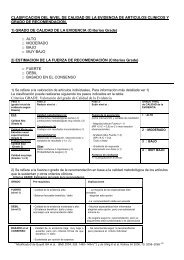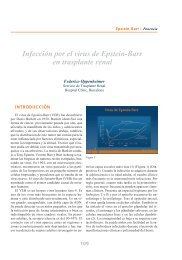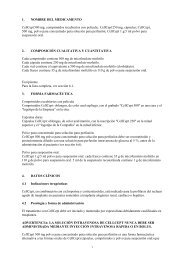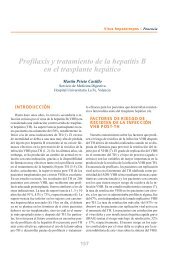Untitled - Roche Trasplantes
Untitled - Roche Trasplantes
Untitled - Roche Trasplantes
You also want an ePaper? Increase the reach of your titles
YUMPU automatically turns print PDFs into web optimized ePapers that Google loves.
PROTOCOL BIOPSIES AND THE DIAGNOSIS OF HUMORAL REJECTION<br />
activity PI3K and AKT, two further cytoprotective cell signaling molecules. Complement<br />
regulation might theoretically be involved in accommodation, too. Under physiological<br />
conditions the endothelial surface in the renal microcirculation (in peritubular capillaries<br />
and glomeruli) is unopposed concerning complement activation via the classical pathway.<br />
In general, four cell-surface inhibitors of complement activation has been identified:<br />
complement receptor 1 (CR1), decay-accelerating factor (DAF, CD55), membrane cofactor<br />
protein (MCP, CD46), and CD59 which are usually expressed in the endothelium at<br />
low or undetectable levels. However, DAF expression can be increased in cultured endothelial<br />
cells in the presence of various mediators like thrombin, bFGF, TNF, IFN-gamma,<br />
or VEGF. In vitro upregulation of DAF inhibits complement-mediated cytotoxicity of<br />
endothelial cells and reduces complement deposition. In animal models it has been shown<br />
that DAF is required to prevent acute antibody-mediated rejection. Alternatively, exposure<br />
to C-reactive protein increases the expression of DAF, CSD59, and MCP by cultured<br />
endothelial cells. Anecdotally it has been reported that increased CD59 expression by<br />
endothelial cells is a common event in acute and chronic humoral rejection and that increased<br />
endothelial-cell expression of DAF can be seen in chronic humoral rejection.<br />
Although this response might function to attenuate acute antibody-mediated allograft<br />
damage, but accommodation is obviously inadequate to prevent the onset of chronic humoral<br />
rejection. Nevertheless, a short term studies of pig-to-baboon solid organ (heart,<br />
lung, and kidney) xenografts showing accommodation supported the concept that accommodation<br />
is a consequence of full inhibition of complement activation. However, further<br />
studies are needed to understand how complement activation can therapeutically<br />
be controlled to achieve accommodation renal transplantation.<br />
THERAPEUTIC IMPLICATIONS<br />
At present, no definite guidelines for treatment of acute and chronic humoral rejection<br />
are available. Various therapy regimes are still evolving but few prospective controlled<br />
studies are currently underway. The most common treatment strategies are based on<br />
the quick as possible removal of the circulating antibodies using plasmapheresis in combination<br />
with immunosuppression targeting B cells as well as T cells. The intravenous application<br />
of immunoglobulin (IVIG) or thymoglobulin represents a frequent therapeutic<br />
approach that effect especially B cells and antibodies or to a lesser extent also plasma<br />
cells (thymoglobulin) as the source of antibodies. IVIG induces apoptosis in B cells and<br />
monocytes as well as inhibiting binding of donor-reactive antibodies to target cells in 80%<br />
of patients, although the molecular mechanism is not known in detail. IVIG and thymoglobulin<br />
might also function, in part, by inhibition of complement activation.<br />
New therapeutic strategies are available in form of highly specific monocloncal antibodies<br />
selectively inhibiting B cells (rituximab). This antibody binds to CD20, a surface molecule<br />
expressed by precursor and mature B cells, and leads to transient B-cell depletion,<br />
with typical B-cell recovery after 6-9 months. Preliminary studies indicate that rituximab<br />
65




